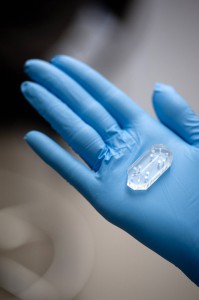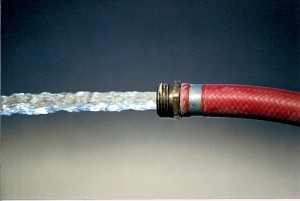
A slippery coating inspired by the surface of a pitcher plant could help keep IV lines free of bacteria and blood clots. (kleo_marlo/Flickr)
Pick up a piece of IV tubing (should you happen to have one nearby) and run your hand down the length of it. The surface feels pretty smooth, yes?
From the perspective of bacteria and platelets, that same surface is pockmarked with nooks and crannies where they can stick, aggregate and start to form blood clots (in the case of platelets) or hard-to-combat biofilms (in the case of bacteria).
That’s a problem for hospital care. Contaminated central lines (IV lines threaded into deep veins for long periods of time) cause upwards of 41,000 costly and potentially fatal central line-associated bloodstream infections (CLABSIs) in pediatric and adult patients in U.S. hospitals every year. And blood clots can preclude patients, including premature babies, from receiving new lung-protecting treatments because they can’t tolerate anticoagulants.
Both problems may have a single solution. Clinicians in Boston Children’s Department of Newborn Medicine and engineers at Harvard’s Wyss Institute for Biologically Inspired Engineering have collaborated to develop a coating, inspired by pitcher plants, that makes the surfaces of clinical-grade plastics so slippery that platelets and bacteria can’t get a toehold. Full story »

Just like Goldilocks wouldn’t eat porridge that was too hot or too cold, blood vessels won't grow properly in tissues that are too stiff or too loose. (Project Gutenberg/Wikimedia Commons)
In the tale
Goldilocks and the Three Bears, Goldilocks tries all of the bears’ porridge, chairs and beds, finding that only the little bear’s things were just right. Everything else was a little off for her…too hot or too cold, too hard or too soft and so on.
Similarly, for everything to work as it should in the body, things need to be just right. Blood pressure shouldn’t be too high or too low; organs can’t be too big or too small, etc.
Donald Ingber, MD, PhD, and his lab in Boston Children’s Vascular Biology Program take this “just right” approach when thinking about how organs and tissues are structured. Recently, he and a member of his research staff, Akiko Mammoto, MD, PhD, discovered that by changing the stiffness of the surrounding tissues—not too loose and not too tight— they could keep blood vessels from leaking. Their finding could have real consequences for people with sepsis or other diseases featuring leaky vessels. Full story »

It may not look like it, but it's a lung, just in chip form.
They don’t look like much sitting in your hand. A few pieces of clear plastic, each smaller than an Altoids tin, with channels visible inside and holes for plugging tubing into them.
But fill them with cells and treat those cells the right way, and they turn into something amazing: tiny hearts, lungs, guts, kidneys.
They’re “organs on chips,” and they represent what’s probably the most comprehensive effort to date to physically model the functions of whole organs for drug development and disease research.
Developed by a team of biologists and engineers led by Donald Ingber, MD, PhD, a member of Boston Children’s Hospital’s Vascular Biology Program and director of the Wyss Institute for Biologically Inspired Engineering at Harvard, they’re the building blocks for an ambitious project to create an artificial multi-organ system—essentially, a whole body on a chip. Full story »

Blood should flow through an artery like water through a hose. The stress of a blockage can encourage clots to form, potentially resulting in a heart attack or stroke. Donald Ingber thinks the same forces could be used to help dissolve clots. (Beth Kingery/Flickr)
Grab a garden hose. Put your thumb over the end, but not all the way, and turn the water on. What happens? The water coming out of the hose gets squeezed as it tries to push past your thumb, putting a lot of force on the molecules in the water and making a big spray.
Now do the same thing with an artery: Partially block it with a clot and let blood flow through it. In this case, the force you’ve created in the artery could be lethal—creating fertile ground for blood clots that could lead to a stroke or heart attack.
But what if that combination of force and pressure could be used to stop something like a stroke instead? What if it could release a clot-dissolving drug on the spot? Donald Ingber, MD, PhD, a member of Boston Children’s Hospital’s Vascular Biology Program, had wondered that for many years. To find out, Ingber, who also directs the Wyss Institute for Biologically Inspired Engineering at Harvard, had his team start with a simple question: How do clots form? Full story »












